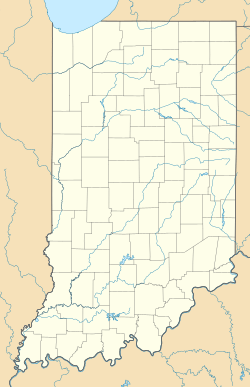Cathedral of the Holy Angels (Gary, Indiana) facts for kids
Quick facts for kids Cathedral of the Holy Angels |
|
|---|---|

Cathedral from the southeast in 2012
|
|
| 41°35′55.99″N 87°20′55.93″W / 41.5988861°N 87.3488694°W | |
| Location | 640 Tyler Street Gary, Indiana |
| Country | United States |
| Denomination | Roman Catholic Church |
| History | |
| Status | Cathedral/Parish |
| Founded | September 1906 (parish) |
| Founder(s) | Msgr. F. Thomas Jansen |
| Dedication | Holy Angels |
| Dedicated | January 29, 1950 |
| Architecture | |
| Functional status | Active |
| Style | Gothic Revival |
| Groundbreaking | 1947 |
| Specifications | |
| Number of spires | One |
| Materials | Limestone |
| Administration | |
| Diocese | Gary |
The Cathedral of the Holy Angels is an important Catholic cathedral located in Gary, Indiana, United States. It is the main church for the Diocese of Gary. It is also the home of the Holy Angels Parish, which is like its local church community.
Contents
History of the Cathedral
Early Beginnings
The Holy Angels Parish started in September 1906. It was founded by Reverend Thomas F. Jansen. This was the very first Catholic church community in the city of Gary. At first, church services were held in a tavern. Later, the first church building was built, which also served as a school. Many of the early church members came from Eastern Europe, Ireland, Germany, and Italy.
Growing and Building
The Holy Angels School opened in 1909. The School Sisters of Notre Dame were the first teachers there. The church community slowly grew over the years. By the 1940s, a bigger church building was needed. Reverend John A. Sullivan was the leader of the church when the current building was constructed. It was built in the Gothic Revival style, which looks like old European cathedrals. The first stone was placed on October 26, 1947. The church was officially opened on January 29, 1950, by Bishop John F. Noll.
Becoming a Cathedral
A big change happened on December 10, 1956. On this date, Pope Pius XII created the Diocese of Gary. A diocese is a special area managed by a bishop. When this new diocese was formed, Holy Angels Church became its main church, known as the cathedral.
Changes Over Time
In the 1960s, the church community became more diverse. Many African American and Latin American members joined Holy Angels. This happened when other local churches, St. Anthony's and Sacred Heart, closed. In 1965, the old school and convent (where nuns lived) were taken down. A new, two-story building was constructed for $1.2 million. This new building had classrooms, a convent, a gym, a cafeteria, and a hall for church events. On June 7, 1994, the school's name was changed to the Sister Thea Bowman School. Today, it is a special public school called the Thea Bowman Leadership Academy.
Exploring the Cathedral's Design
Inside the Worship Space
When you enter the main worship area, you first see the baptismal pool. This pool is where people are baptized. It is made of travertine marble. The four pillars at its base came from the church's old main altar. The base and top of the ambry, which holds the holy oils, used to be the baptismal font. The top part is made from black walnut wood.
The main altar is made of marble and is shaped like a square. Around the altar on the floor, you can see angels made in mosaic art. These angels show different people from around the world: African, Caucasian, Asian, and Latin. This represents the diverse community of the diocese. At the back of the cathedral, in the apse, is the reredos from the old main altar. It shows a scene of Calvary. The cathedra, which is the bishop's special chair, sits in front of the old reredos. It was carved from black walnut wood and put in place in 1996. A carved angel stands next to the bishop's chair. The ambo, where readings are given, is made from the same materials as the altar and reredos.
Special Areas
The tabernacle is located in the Blessed Sacrament Chapel. This is where the Eucharist is kept. Behind the tabernacle, four carved angels are shown in worship, forming a cross. The shrine of the Holy Angels is in the east transept. This shrine has an icon, which is a special religious painting, called the Synaxis of the Holy Angels. It was painted in an Ethiopian-Coptic style. This shrine honors church members and priests who have passed away. Bishop Andrew Gregory Grutka, who was the first bishop of Gary, was buried here in 1993.
Leaders of the Cathedral
The following priests have served as the leaders of the Holy Angels Parish. Since 1956, they have also been known as the cathedral rector, which is a special title.
- Msgr. F. Thomas Jansen (1906–1942)
- Msgr. John A. Sullivan (1942–1963)
- Rev. John C. Witte (1963–1968)
- Rev. Casimir E. Sederak (1968–1971)
- Rev. Don C. Grass (1971–1983)
- Rev. Richard A. Emerson (1983)
- Msgr. Joseph A. Viater (1983–1985)
- Rev. William E. Vogt (1985–1986)
- Rev. Andrew Daniels, OFM Cap (1986–1992)
- Rev. Matthew Iwuji (1992–1997)
- Rev. Robert P. Gehring (1997–2007)
- Rev. Jon J. Plavcan (2007–2012)
- Rev. Michael J. Kopil (2012–2016)
- Rev. Kevin P. McCarthy (2016–2018)
- Rev. Michael Surufka, OFM (2019–)
See also
 In Spanish: Catedral de los Santos Ángeles (Gary) para niños
In Spanish: Catedral de los Santos Ángeles (Gary) para niños



